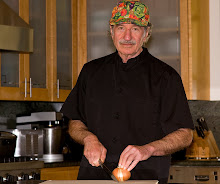Move over Joe the Plumber and Larry the Cable guy. There is a new hero in town. His name is John McIntyre, AKA John the Laser man.
John is one of the new breed of techno-medical entrepreneurs who supplies specialized medical equipment to hospitals. Many facilities find it advantageous to rent rather than own his extremely sophisticated lasers that are used to treat kidney stones.
Prior to April 2009, John, like many of his fellow brethren, would bring along his welcome wagon of "goodies" for the OR staff to munch on. He would set up his cornucopia of unhealthful delights in the staff lounge and would be amazed just how quickly his fat, sugar, and salt laden morsels were consumed by the personnel.
John covers a wide geographical area, from Santa Rosa in the north to Gilroy in the south, and as far east as Stockton. Prior to arriving at each individual hospital, he would stock up on sodas, cookies, chips and donuts. He would then set up his wares to the delight of all concerned.
At some point John became troubled over the feeding frenzy that ensued whenever he presented his goodies to the staff. His epiphany occurred when he became aware of Dr. David Kessler, former FDA commissioner, and former dean of UCSF and Yale Medical Schools, and his new book "The End of Overeating". Kessler's premise is that the processed food trio of high fat, sugar, and salt, hyperstimulates parts of the brain and creates an almost addictive state in individuals who consume these products. McIntyre was observing this phenomenon first hand and was coming to the realization that he had to change what he had been doing all these years.
The typical hospital staff has few options when it comes to consuming a more healthful diet. Unfortunately this is not just a Bay area problem. In a study conducted in 2005 by Physicians Committee for Responsible Medicine, the survey of 40 hospitals or hospital systems across the country determined that 62% of what the hospitals considered their "healthiest entree" derived more than 30% of the calories from fat, and a few derived more than 50% from fat. Fewer than one third of hospitals surveyed had a daily salad bar or offered a vegetarian entree. This does not bode well for a country in which two thirds of its inhabitants are overweight or obese.
As hospitals are getting out of the "food" business, the fast food outlets are moving in with abandon. Their Field of Dreams approach is, build it and they will come, and their strategy appears to be quite successful. In a survey taken of 234 hospitals, 42% had a fast food outlet on the premises. McDonalds, Burger King, Pizza Hut, KFC and Dunkin Donuts are familiar sightings at the most prestigious hospitals in the country. Indeed, the Cleveland Clinic, lauded by the Obama administration as a model for the future of health care, has been fighting a battle with McDonalds and Pizza Hut over their facilities in the hospital cafeteria.
McDonalds USA, the leading food source provider in the USA with over 13,700 facilities, has supported National Nurse's Week with a special "new southern style chicken biscuit" breakfast. This is the type of diet that has been shown to increase the risk of type 2 diabetes, reaching pandemic proportions in the US and other countries that follow a standard American diet. The incestuous relationship of a fast food outlet housed in the same facility as a Coronary Care Unit has prompted Dr Andrew Weil to describe these facilities as" surgery with a side of fries".
One positive exception to these developments is the Kaiser Hospital System which has established weekly farmers markets at 31 sites in Northern California. This gives the staff an opportunity, at least once a week, to partake in fresh fruits and vegetables. Conversely, as an illustration of the powerful influence that high fat foods have on us, one physician informed me that the longest line at the market was at the sausage vendor.
John's experience has caused him to radically alter his own diet. He went from a cholesterol laden, animal based diet to one that is largely based on whole grains, legumes, fruits, and vegetables. In addition to his personal metamorphosis, he began to change the type of treats he brought to the hospitals he visited. Gone were the donuts, pastries, and chips --which were replaced with fresh fruit and vegetable salads. On his way to each hospital he stops at the local green grocer and purchases a wide variety of produce. Upon arriving he sets up his own fruit and salad bar in the lounge. The response has been phenomenal. John reports that as soon as the staff sees him, they have an almost Pavlovian response and immediately run to where he has set up his wares.
John, the Laser Man, with his healthful goodies has become the new hero in town.
Saturday, December 19, 2009
Subscribe to:
Post Comments (Atom)


No comments:
Post a Comment